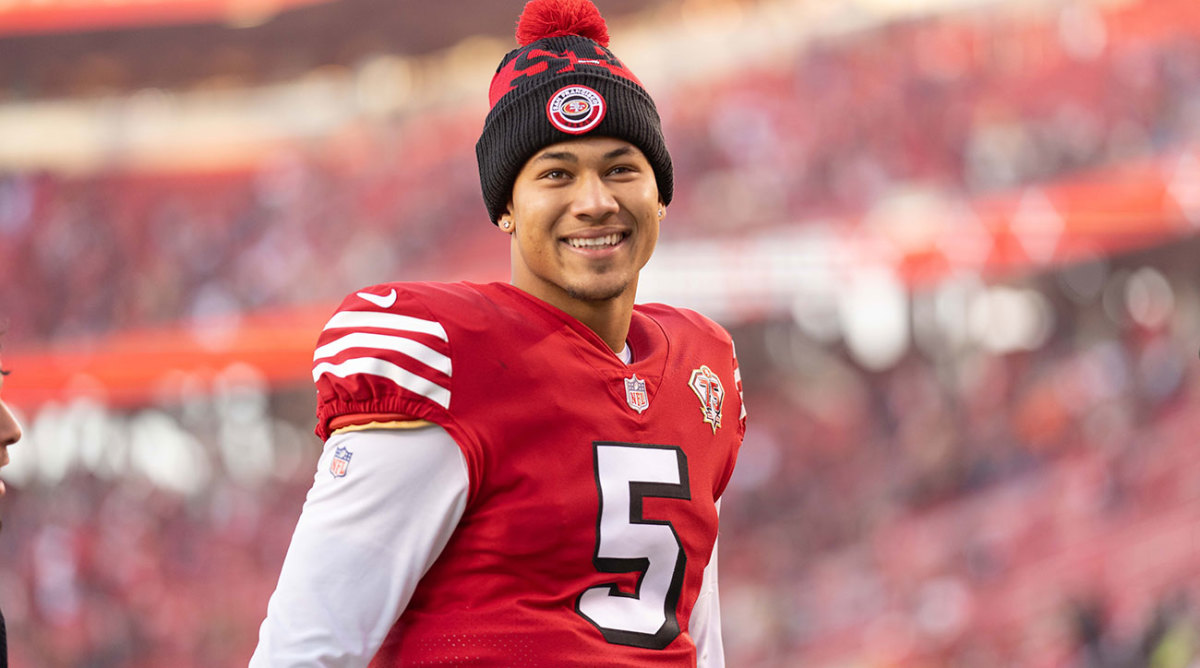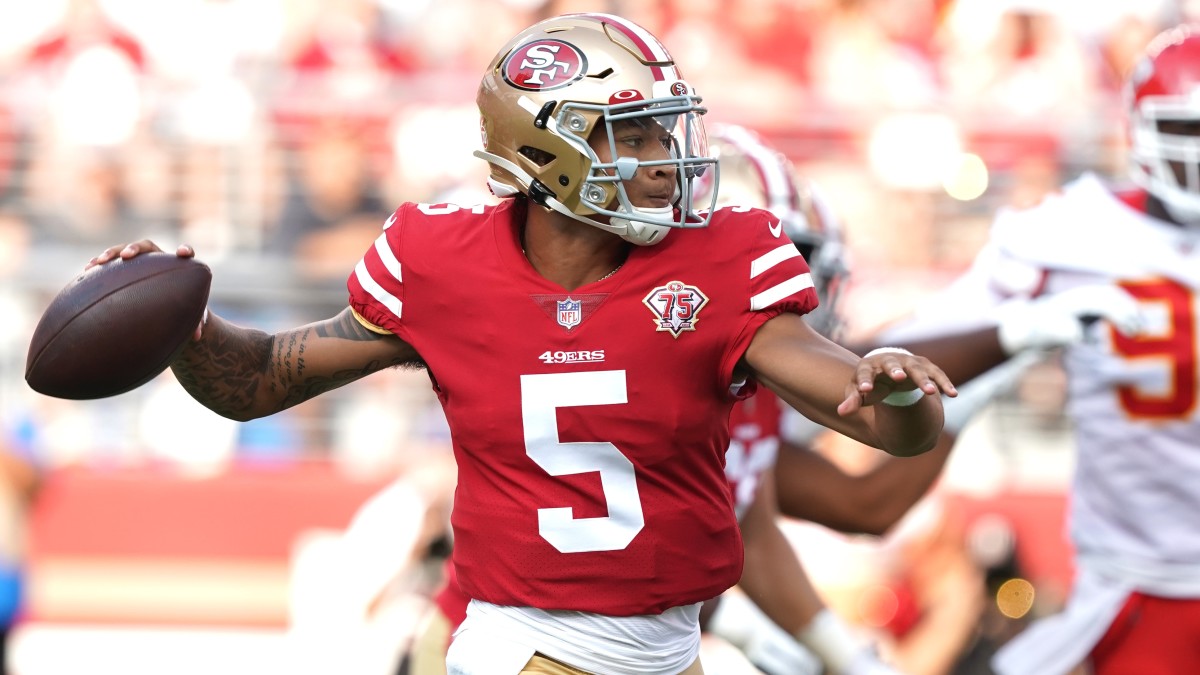Don’t Write Off Trey Lance’s Rookie Season Just Yet

In Trey Lance’s first and only start of the season, he dropped back on a first-and-10 at his own 35-yard line at the end of the first quarter and faked a handoff against a four-man Cardinals front that had added an extra blitzing defender just before the snap.
With his three seconds in the pocket, he was able to see the fruits of the Kyle Shanahan system laid out in front of him. The tight end was open on a modified wheel-type route to his blind side, forcing the outermost Cardinals defender in the middle of their zone to keep an eye on him. Kyle Juszczyk popped out at the right time and flashed in order to freeze another Cardinals defender in the center of their zone and force him to stand pat. This allowed Lance to look at the interplay between wide receivers Deebo Samuel and Travis Benjamin. Having already established earlier in the game the willingness to try Benjamin on some intermediate and deep throws, he had the respect of the Cardinals’ secondary, which floated a second defender with Benjamin on a go route. Because so many Cardinals defenders were already conflicted by other options, Lance followed Samuel as he ran the quintessential Shanahan-ian route: an in-breaker that essentially sliced the Cardinals’ defense in half. Samuel was behind the middle-tier defenders who were already conflicted by Juszczyk and the tight end (trying to positively identify him via GamePass was more difficult than recognizing million-year-old shards of fossilized dinosaur bones in the Sahara) and in front of the Cardinals’ deep-tier defenders chasing Benjamin as if he had taken their bicycle.
The result was a pocket of space about seven yards wide on either side of the receiver. All Lance had to do was put a little touch on a pass and create, with little effort, a 26-yard gain.

Lance, the No. 3 pick in the 2021 draft and the least-frequently-used first-round rookie quarterback from this year’s class, could start for the 49ers in Week 17 with Jimmy Garoppolo recovering from a chipped bone and ligament damage in the thumb on his throwing hand. For the season, Lance has just 48 passing attempts and 30 rushing attempts over 116 total snaps. The prospect of starting a quarterback with a lifetime completion percentage in the low 50s and who, despite being traded up for, could not beat out Garoppolo for the starting job, seems dubious, but breadcrumbs left behind from his action tell a different story.
In fact, the 49ers might be better than all right. At 8–7 and in possession of the NFC’s sixth seed, Lance could lead them into the playoffs … and beyond.
Garoppolo has been better than expected this year. A composite of completion percentage over expectation and expected points added per snap rates him as the third-best quarterback in the NFL this year, behind only Aaron Rodgers and Joe Burrow. Garoppolo’s CPOE is higher than that of Matt Stafford, Tom Brady, Patrick Mahomes and Josh Allen. Based on his current contract structure, it makes no sense for the 49ers to get rid of him before the 2022 season, unless they’re blown away by a trade offer. At the worst, if Lance has a dream offseason, Garoppolo could still be the best backup quarterback in the NFL.
But Lance’s detractors are selling his previous performances a bit short. For one, his only start was without George Kittle, whose return has coincided with a surge in the running game, as well as the utilization of Samuel as a featured back, which has also helped diversify the 49ers’ offensive portfolio. Samuel had one rush for 13 yards in Lance’s Week 5 start, which went for a touchdown. He didn’t start averaging more than five carries per game for another month, and while Lance had Kittle for two quarters against the Seahawks, the offense wasn’t close to resembling what it does now.
In limited snaps, Lance seemed to even out with his legs the disruptions in timing and what he lacked in polish. He threw completions that should not have been, like a pass to Brandon Aiyuk in tight coverage that yielded a long run after the catch in the third quarter. His lone interception wasn’t a horrible idea, dropping a ball into a soft triangle of defenders, but the pass came in hot and skied over Benjamin’s head into the arms of Budda Baker. A quick slant to Samuel nearly resulted in a hospital ball, with the placement just behind the pace of the route and a defender oncoming.
On the flip side, Lance was about a quarter inch from both scoring a rushing touchdown and converting another fourth-down early in the game that could have yielded points. A memorable drop from Mohamed Sanu and a completion to Sanu on a critical fourth down, while a hair late (the ball was still in Lance’s hands when Sanu hit the break on his out route), was out in enough time for a first down.
The rub here—the reason the 49ers didn’t trade Garoppolo and have Lance start every game after that—was obviously that Shanahan’s system is basically a set of rules for the offense. Lance is being asked to read defenses the same way as the coach, the coordinator, the running backs, the receivers and the tight ends. Instead of game planning for an opponent’s weakness, a Shanahan offense forces opponents to choose between one kind of self-inflicted wound or another, which develops over the course of successful early downs. It stands to reason that Lance, in his first start, didn’t create that kind of conflict, despite some of his successes, which is why the 49ers were overdependent on Lance as a ballcarrier (his 84 yards was one of the highest totals for a rookie quarterback in his first start in NFL history).
A second watch of the Cardinals game, though, yields a few key takeaways that should be considered before describing a Lance-starting scenario as doom and gloom.

• The Cardinals were ideally suited to defend Lance and that iteration of the offense. Simply put, defensive coordinator Vance Joseph had a good game. A lot of the times Lance scrambled aimlessly or threw incomplete passes, the receivers were pretty well covered.
• Arizona’s speedy linebacking corps managed to shut down a lot of the intermediate throws coming off play-action that could have helped Lance get into rhythm and win the early downs to Shanahan’s liking. A lot of the early-game, exotic backfield looks were tracked pretty well by the defense.
• Lance’s mobility created plays outside of the structure that, with Garoppolo in the lineup, would have been sacks, fumbles, interceptions or throwaways. He can, with very little effort, get the 49ers out of a situation where their backs are up against the goal line by virtue of being big and fast.
• Lance has not had a snap since Nov. 21. In that time, Shanahan said, he had his best four weeks of practice since becoming a member of the 49ers. While this could obviously be hyperbole, it tracks with quarterbacks’ developing in the Shanahan system. As we said, it’s a set of rules. These take time to learn, especially for a quarterback who, for most of his life, could overcome anything solely through the physical gifts he was bestowed. As his inclination to run diminishes—and as the 49ers make that less of a priority offensively—he’ll likely improve as a passer.
Since Lance last had a crack as a starter, the running game has transformed to something reminiscent of the team’s 2019 Super Bowl run, though not quite as potent. Kittle is playing at an MVP level and, more importantly, is blocking like one. Before we write the book on Lance’s first season, he deserves a chance to show his skills in a truer representation of the 49ers’ offense, just like the look he got against the Cardinals on that long pass to Samuel.
• Madden’s Revolutionary Impact, Style Will Never Be Replicated
• MMQB: How the Patriots Push the Bills to Improve
• Bengals Already Better Than in Marvin Lewis Era
• How Jakob Johnson Is Helping Define the Post–Tom Brady Patriots
